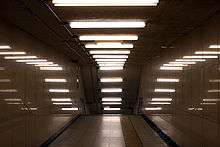Wikijunior:How Things Work/Fluorescent Lamp
< Wikijunior:How Things Work
A fluorescent lamp consists of a tube containing a gas and special coating on the inside surface. A coil inside the tube is then heated and emits electrons which collide with the atoms of gas inside the tube. This produces invisible ultraviolet rays which when contacting the phosphor coating on the tube turn into visible light which is what we eventually see. Traditional fluorescent bulbs are the long tubes that one typically sees in overhead building lighting, but compact fluorescent lamps (CFL) are becoming more common and are starting to replace incandescent light bulbs in everyday lights in our homes. Fluorescent lamp are much more efficient than incandescent ones because they only produce the white light we want and do not produce all of the heat associated with incandescent bulbs (which glow because they are hot).
Who invented it?
Many people did, including Thomas Edison, Georges Claude and Heinrich Geissler.
How does it get power?
When you plug the cord into a wall, it uses electrical current. When the current gets faster, it heats up, giving it a glow.
How does it work?
It excites mercury vapor, and a phosphor lights up, making light.
How dangerous is it?
Mercury is very poisonous and can kill. The lamp should not be used if damaged as it may leak mercury fumes. Instead if should be carefully disposed of. Often local authorities have special instructions for the disposal of fluorescent lamps to make sure the mercury does not spread into the environment or nearby water courses.
What does it do?
Light is produced when the phosphor lights up.
How has it changed the world?
It produces light.